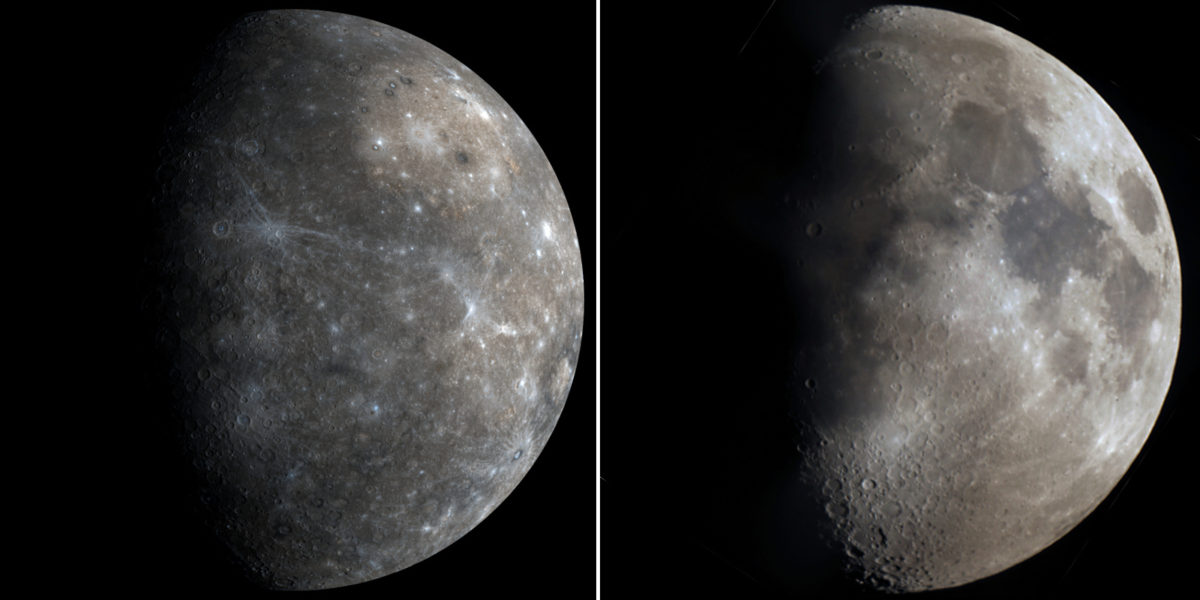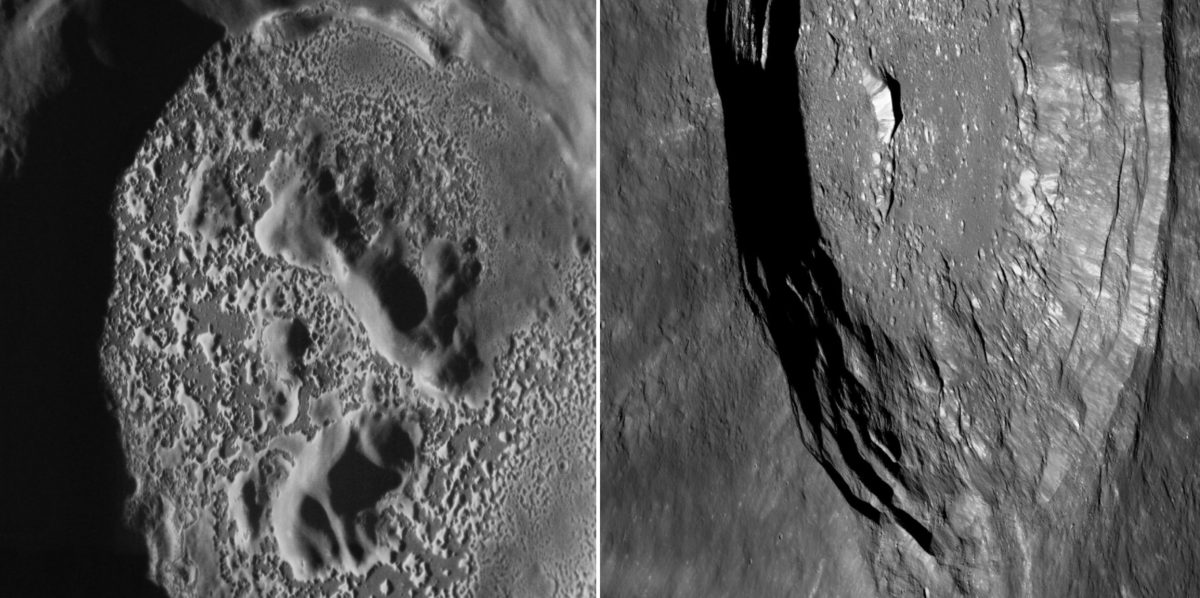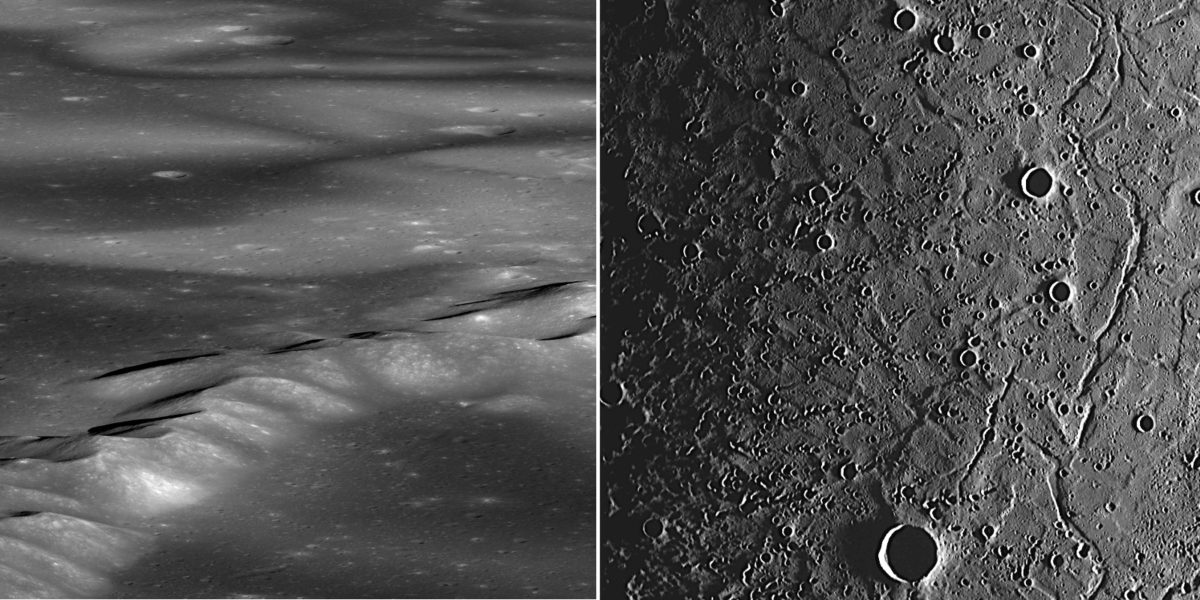Bill Dunford • May 13, 2013
Dueling Desolations: Mercury vs. the Moon
The gray, cratered surfaces of the planet Mercury and the Earth's moon are in some ways twins. At first glance they can even be hard to tell apart. Both are still, airless places. Few corners of what Shelley called heaven's free wilderness are more stark than these two worlds. Carl Sagan wrote of our "blasted and lifeless" satellite, and once described Mercury as an "ancient and broiling wasteland."
Yet Buzz Aldrin famously called the moon's desolation "magnificent," and exploring both the moon and Mercury reveals a certain desperate beauty.
While they are both scarred with craters, in other ways the two worlds tell very different stories, and each conceals unique mysteries. Here are a few side-by-side comparisons--can you immediately tell which is which?
First off, a relatively easy one.

In this global view the most obvious giveaway are the moon's "seas," which together form its familiar face. These are vast plains of once-liquid rock. Mercury, too, shows signs of lava flowing over its surface. In fact, many of its craters are completely buried in it. But Mercury still lacks those obvious oceans of stone.
One of these images was captured on the ground through a telescope, the other "in person" by a passing spacecraft. Both reveal something hidden: color. Mercury and the moon look mostly gray to the naked eye, but if you digitally exaggerate the natural color in the pictures, you suddenly see blues, yellows, and flecks of orange. This is another clue to the differences between the two worlds, since it turns out that those colors result from rocks with significantly different compositions.
Another distinction are the crater rays. The big craters on both the moon and Mercury formed in violent impacts. Surrounding the younger ones you can sometimes still see long streaks formed by the ejecta that was blasted out of the ground. The moon has several sets of brilliant rays, such as those that radiate from the crater Tycho. But Mercury's rays are often even brighter, and in places they are visible stretching across nearly an entire hemisphere.
Next, a look at some craters. Many craters on Mercury are at first indistinguishable from their lunar counterparts. But in some of them something strange is going on. For example, which one of these is a Mercurian crater?

On the left is Mercury's Kertesz Crater, including its striking example of "hollows." These are very bright areas with a slight blue-ish tint in color photos where some process is carving out the landscape. The prevalent theory is that the Sun beats so heavily on Mercury's surface that rock is basically sublimating away, turning directly from a solid into a gas. The result is a landform that looks somewhat like warming ice fields on the Earth or Mars, but instead of frozen water or dry ice, it's actually rock that's disappearing under the intense sun.
Of course, one of the strangest secrets that Mercury explorers have just recently confirmed is that despite all that heat, there are actually large deposits of water ice there. Because there is no air, when infernal daytime gives way to crystal clear night on Mercury, most of the heat radiates away and temperatures plummet. Near the planet's poles there are deep craters where the sun never shines at all. It's within those permanent shadows that the ice hides. The moon has some ice too, but Mercury's supply is ironically larger.
Finally a comparison of some distinctive landscapes in both places.

The moon doesn't have a global magnetic field. Scientist were surprised when they discovered that Mercury has a strong one. So it's a bit of a twist once again that the swirly patterns across the lunar hills on the left are caused by magnetic fields. Particles from the sun continually bombard the surface of the moon, darkening it over time. In the moon's Mare Ingenii, though, relatively small local magnetic fields shield some places from that solar wind and intensify it in others, resulting in the lovely swirling patterns.
The intensely rugged terrain on the right is typical of Mercury. Deep trenches formed across many parts of the planet due to complex geological motion: lava domes swelled and collapsed; molten rock poured out of fissures; the entire planet shrank as it cooled. Most of that activity died long ago, but the scars are still there.
Mercury is full of mysteries, right down to its outsized core where a bizzarre, tilted magnetic dynamo beats. To find out much more about that and other things that the ongoing MESSENGER mission is exploring, join this recent video hangout that features some face time with MESSENGER deputy principal investigator Larry Nittler. He explains why the hardy MESSENGER spacecraft has to "sneak up" on the planet every day, how it tastes the chemical composition of its surface, and how it might be in the perfect position to spy on some comets that will be swinging by the sun later this year.
Sadly, even though the spacecraft is healthy, due to budget constraints those observations may never take place. Join the Planetary Society in its efforts to restore NASA's planetary science program.
Support our core enterprises
Your support powers our mission to explore worlds, find life, and defend Earth. You make all the difference when you make a gift. Give today!
Donate

 Explore Worlds
Explore Worlds Find Life
Find Life Defend Earth
Defend Earth

